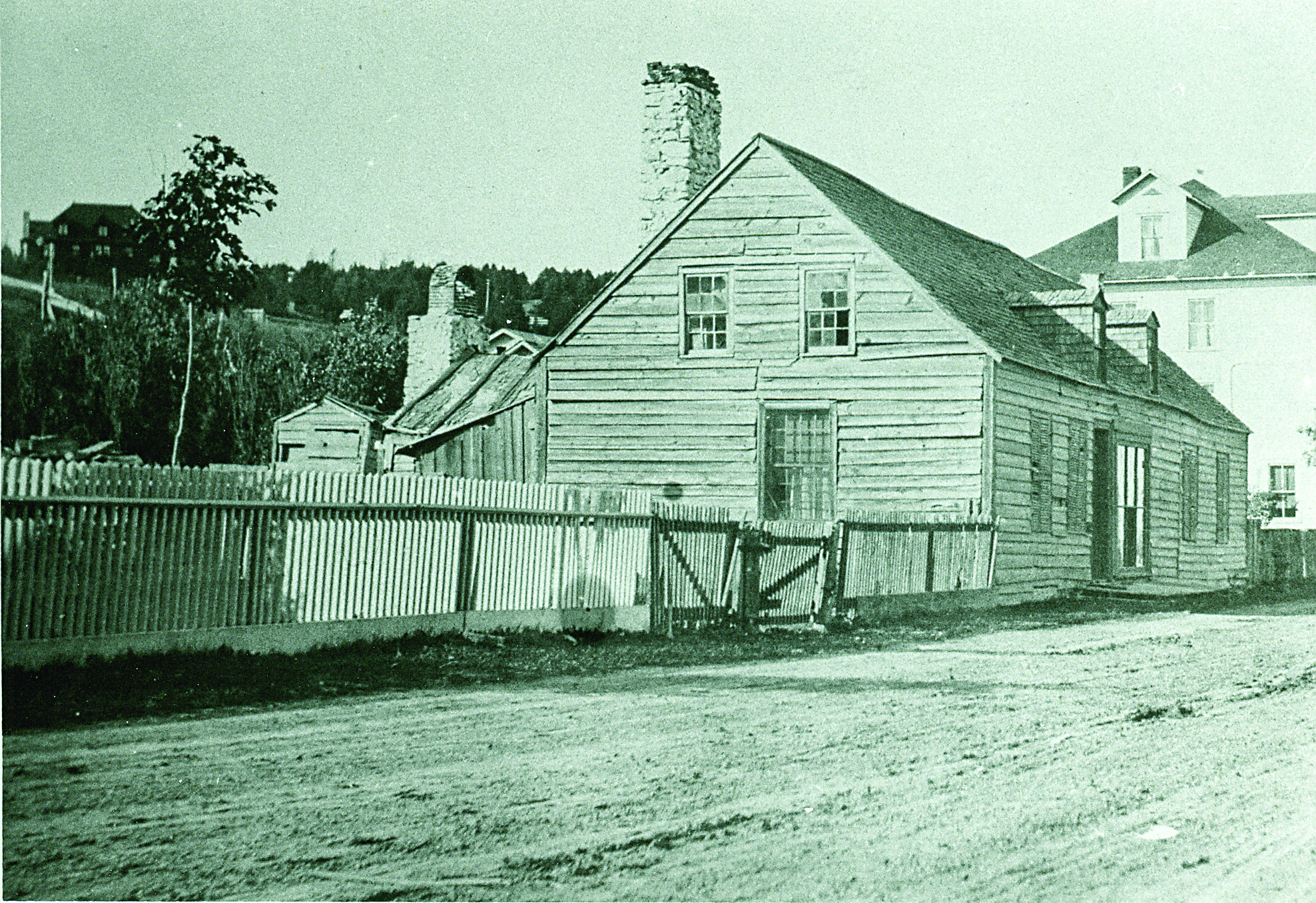
House & Homeland
The oft-overlooked island tale of local Native Americans’ struggle to stay in northern Michigan finally finds a home.
By Patrick Sullivan | May 20, 2017
You grow up in Michigan, you know a little about Mackinac Island’s landmark events in history: Dr. William Beaumont and the stomach hole experiments, the ill-fated 1763 baggatiway game turned bloody battle at Fort Michilimackinac, the English takeover of Mackinac Island that marked the opening of the War of 1812 … .
What’s less well known, however, is the Anishinabek story on Mackinac Island — and the unfolding of a 19th century drama that threatened the very existence of Native Americans in northern Michigan.
An exhibit in the island’s oldest building, the Biddle House, seeks to change all that.
A PIVOTAL TURN IN HISTORY
A cooperation between the Little Traverse Bay Bands of Odawa Indians and Mackinac Historic State Parks, the history exhibit will look at local Native American history through the eyes of the building’s namesake, Agatha Biddle, an Odawa woman who lived in the island home (pictured above) with her American husband, Edward Biddle, in the early 1800s.
Why Biddle? Biddle, who lived her entire life in the region and would go on to become a fur trade entrepreneur and tribal chief, was a witness to one of the most pivotal times in the region’s Native American history, when 4,000 members of six tribes – Grand River, Muskegon, Grand Traverse, Little Traverse, Mackinac and Sault Ste. Marie – negotiated for their very survival.
THE SCHOOLCRAFT AGENDA
If negotiations were a Hollywood movie, Augustin Hamlin would be the hero.
The villain — at least from the Native American point of view — would be Henry Schoolcraft, famed Indian agent, geologist of Michigan, and chronicler of Native American history.
The scene: bleak. President Andrew Jackson in 1830 had signed the Indian Removal Act, decreeing that all Indians living in the eastern United States should be removed and settled west of the Mississippi. The Cherokee would be forcefully removed from Georgia in what would become known as the Trail of Tears. The Potawatomi would be removed from Indiana and southern Michigan in what is known as the Trail of Death.
“This happened to dozens of tribes. Over a hundred thousand natives are removed. All of Indiana, Ohio, are evacuated,” Hemenway said. “The Potawatomi from southern Michigan are literally hunted down and caught, and they escape and come back. I mean, this is what’s happening during the treaty era.”
Desperate to avoid forced removal to the west, the tribal members of what is now northern Michigan came to the negotiating table to try and hold on to some small part of their ancestral lands. Hamlin, age 23, who recently returned from the Vatican in Rome, where he’d been studying to become a priest, seemed to offer some hope.
“He’s young, and the tribes all entrust him to be an honest interpreter of what’s said because they don’t speak English, and Augustin speaks it fluently, so without Augustin at the table interpreting what’s being said, we very well may have been removed,” said Eric Hemenway, LTBB Odawa director of repatriation, archives and records. “Because on the opposite end of this table is a guy by the name of Henry Schoolcraft.”
Schoolcraft was the Indian Agent for the Michigan Territory. Lewis Cass, who was then Secretary of War under Jackson and had previously been governor of the Michigan Territory, ordered Schoolcraft to get as much land as he could from the tribes.
So Schoolcraft duplicitously entered into negotiations and he acted as though he had the tribe’s best interests at heart.
“It was a massive land-resource grab and displacement of the tribes, and Schoolcraft was 100 percent on board with the removal, but he wasn’t up front with this,” Hemenway said. “When the treaty was being negotiated, he would tell the tribes, ‘Don’t worry, you will never be removed. Nobody will come this far north.’”
But when it came time to sign the negotiated document, it contained a surprise: a clause that stated that the president “may” remove the tribes from Michigan after five years. This concerned Hamlin, and when he translated it to the tribal members, it concerned them. But Schoolcraft insisted they shouldn’t worry about it because it wouldn’t happen.
Complicating matters, said Hemenway, was that tribal members were under great duress. If they didn't sign, the reality of forced removal was real. It was also a time when the tribal members needed compensation: 1835 had been an extremely harsh winter, and they were suffering. Crops had failed, game was scarce, and people were starving. Making matters worse, small pox was ravaging Native populations around the Great Lakes.
“Everything’s stacked up against them,” Hemenway said. “People are dying in droves. Entire villages are passing away due to small pox and measles … Yet they go make the journey to see what was going to happen with their future.”
What happened was grim: The tribes signed the Treaty of 1836, giving up 16 million acres of Michigan in exchange for a small portion of their tribal land and access to natural resources on the ceded lands. It was a huge win for the United States — and no coincidence, Hemenway noted, that one year later, in 1837, Michigan became a state.
“NO. WE’RE NOT GOING”
Two years later, despite what he’d promised, Schoolcraft told the tribes they had to pack up and move west of the Mississippi.
“He tells all the leaders, ‘Go pick your lands in Kansas.’ He doesn’t even let the five years run out,” Hemenway said. “He says, ‘It’s inevitable, you cannot be civilized, you’re too barbaric. This close proximity to white populations is destroying you, you drink too much.’” I mean, he’s giving all these reasons why it’s beneficial for us to be removed, and all the tribes push back and say, ‘No. We’re not going.’”
The tribes had sent scouts to Kansas and found that the land there didn’t suit them — there was no water, no maple trees, and it was far too far away from the sacred land where their ancestors were buried.
Aided by their interpreter Hamlin, the tribes made the case that Schoolcraft’s order was unlawful and that they should be allowed to stay. They pointed out that the treaty said they “may be removed” in five years by order of the president; not “must be removed.” Also, five years had not yet passed, and no order from the president had come.
“The guy who understood this the best, or the guy who could translate it the best, was Augustin Hamlin, and he would fight back against removal over and over again against Schoolcraft,” Hemenway said.
The tribes realized that if they wanted to avoid removal, they needed to mount a political campaign. They wrote letters to presidents and senators. They changed the way they dressed. They altered the way they lived, giving up wigwams and tattoos to become farmers who lived in log cabins and went to church.
Efforts were redoubled in 1841 and continued until the Treaty of 1855 was signed in Detroit, withdrawing all of the unsold public land in Michigan and allotting it to tribal members. By then, the tribes had won the political argument, and the mood in the United States had shifted away from a desire to forcefully remove the Indians; instead, the new Americans wanted the Native peoples to assimilate to their way of life.
“[Native Americans] pulled off this amazing act of resistance to removal with all the odds against them. I mean, the state of Michigan is really starting to grow, populations-wise, especially in the south, so people are slowly making their way up north, and it just accelerates. And the government has all these policies of removing Indians and civilizing them,” Hemenway said. “The tribe actually used that in their argument with the United States by saying, ‘We’re becoming civilized, we go to church, we cut our hair, we’re living in log cabins. This is what you are demanding of us, and we’re doing it, so let us stay home.’”
THE OTHER SIDE OF THE STORY
The portrait of Schoolcraft is further complicated by the fact that his first wife was an Ojibway woman from Sault Ste. Marie who became a noted writer herself.
Later in his life, Schoolcraft, aided by his wife and his access to northern Michigan tribes, published volumes of Native American histories and he became a famous writer. His work, in fact, served as the basis for Henry Wadsworth Longfellow’s epic poem, “Song of Hiawatha.”.
Hemenway said Schoolcraft’s wife, Jane Johnston, was not a moderating influence on his views toward Native Americans and that he exploited Native Americans by publishing their stories, though Hemenway concedes it is fortunate that those histories are preserved.
“So Schoolcraft married into this family, and he acquired all of these stories and oral histories through his native wife, and then he published these. And that’s what really his claim to fame is — it’s being this historian,” Hemenway said.
Hemenway said Schoolcraft also left behind records of his racism and bigotry. Even in an era when racism and bigotry were commonplace, he said, Schoolcraft was a standout.
“I’ve read a vast number of his letters and his annual reports back to the Secretary of War, and his recommendations, and the racism and bigotry that he uses, which is common for the day, he uses it on a whole other level,” he said. “You know, he is always advocating that we be removed because of our insurmountable barbaric state.”
The bigger villain in all of this, however, is Andrew Jackson, the architect of the Indian Removal Act. Hemenway said he doesn’t understand how Jackson can be so revered today that he has a place on the $20 bill.
“I think of this as a really dark, dark period for Native history and just American history overall. This is the epitome of genocidal policy and action,” he said. “So many people were removed by force, and so many people died, and families suffered tremendously when they were removed and finally relocated into Oklahoma, Kansas. And the stress and the pain caused by this, not just for the Odawa, but all these tribes east of the Mississippi, I feel a real strong motivation to educate people about the other side of the story.”
Native History, Phase II
Renovation of the Biddle House could begin as early as next year and will mark the second phase in a project to tell a fuller account of Native American history on Mackinac Island.
The first piece of the project — the Native American Cultural History Trail — was installed on the island and opened last summer. It circles the island and offers six stops that tell the story of Native Americans from pre-contact through today. There are turn-outs, bike racks, benches and interpretive signs at each of the stops.
The second phase is the planned indoor museum at the Biddle House. Phil Porter, director of the Mackinac State Historic Parks said they have applied for a $200,000 grant from the Institute of Museum and Library Services. If it is awarded, construction on the exhibit would begin next winter, and the exhibit would open in 2019.
Trending

Springtime Jazz with NMC
Award-winning vibraphonist Jim Cooper has been playing the vibraphone for over 45 years and has performed with jazz artist... Read More >>
Dark Skies and Bright Stars
You may know Emmet County is home to Headlands International Dark Sky Park, where uninterrupted Lake Michigan shoreline is... Read More >>
Community Impact Market
No need to drive through the orange barrels this weekend: Many of your favorite businesses from Traverse City’s majo... Read More >>


